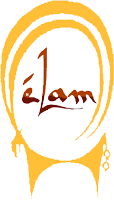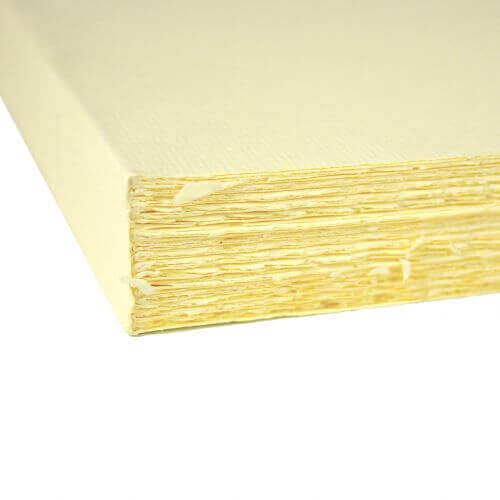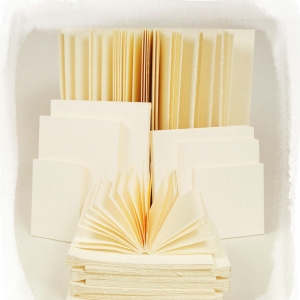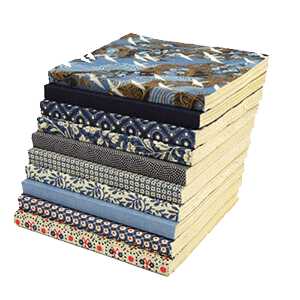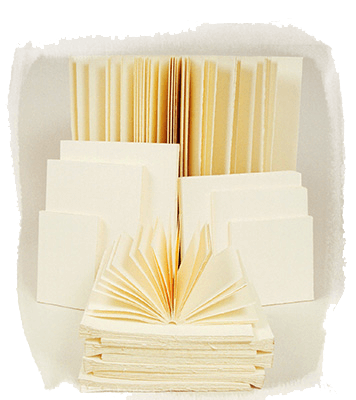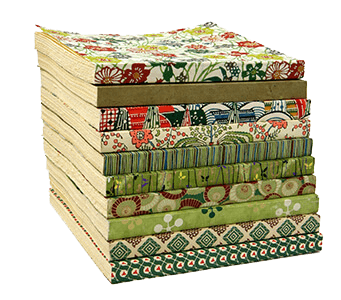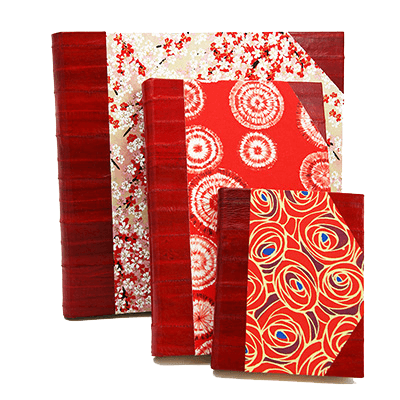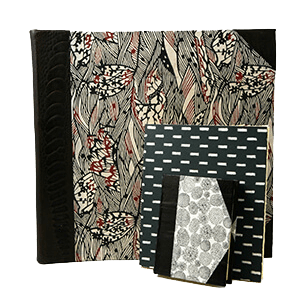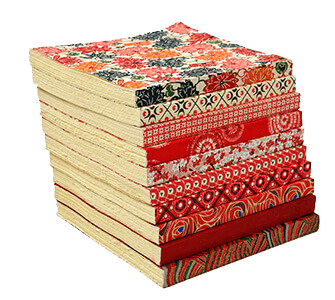Notebooks
Fine bookbinding.
Soft or hardcover.
Inside paper: acid free Fabriano laid paper, 180g/m², cream.
Cover papers
 In this range (scrapbooks) the cover paper is in the same than the inside paper. It is an acid-free laid paper manufactured by the family business Fabriano with a balanced environmental impact (FSC certification). It was in Fabriano that the first paper mill in Europe appeared at the end of the 13th century. The interior paper of our books continues to be manufactured folowing this tradition. It has a very good water resistance which makes it the ideal paper for all kind of techniques (pencil, marker, gouache, watercolor).
In this range (scrapbooks) the cover paper is in the same than the inside paper. It is an acid-free laid paper manufactured by the family business Fabriano with a balanced environmental impact (FSC certification). It was in Fabriano that the first paper mill in Europe appeared at the end of the 13th century. The interior paper of our books continues to be manufactured folowing this tradition. It has a very good water resistance which makes it the ideal paper for all kind of techniques (pencil, marker, gouache, watercolor).
 The history of this paper begins in the Venice region in the second half of the 17th century in the famous printing house Stamperia Remondini which manufactured all kinds of printed papers and books from wooden blocs. After two centuries of activity this empire is dismantled and part of the printing devices is transferred to the city of Varese where the common name of this paper comes from. Historically these floral papers are used in bookbinding for the guard pages. It is a smooth and matte paper that keeps an vintage touch despite the industrialized printing technique.
The history of this paper begins in the Venice region in the second half of the 17th century in the famous printing house Stamperia Remondini which manufactured all kinds of printed papers and books from wooden blocs. After two centuries of activity this empire is dismantled and part of the printing devices is transferred to the city of Varese where the common name of this paper comes from. Historically these floral papers are used in bookbinding for the guard pages. It is a smooth and matte paper that keeps an vintage touch despite the industrialized printing technique.
 Chiyogami (Japanese: 千代紙, (ちよがみ) literally 1,000 years old paper. Hand-screened paper since the Edo era (18th century) traditionally from kimono motifs (Yuzen). These papers are often embellished with light touches of gold or silver that delicately raise the colors.
Chiyogami (Japanese: 千代紙, (ちよがみ) literally 1,000 years old paper. Hand-screened paper since the Edo era (18th century) traditionally from kimono motifs (Yuzen). These papers are often embellished with light touches of gold or silver that delicately raise the colors.
 Katazome-shi paper is printed using an ancestral stencil technique (katagami) in which each colour from natural pigments is applied with a brush. The patterns and colours used are characteristic of Okinawa Prefecture in Japan. The very colorful bingata style, was rehabilitated by the great craftsman-artist Serizawa. The rendering is rather rough similar to a "block print" and the colors of a very matte appearance.
Katazome-shi paper is printed using an ancestral stencil technique (katagami) in which each colour from natural pigments is applied with a brush. The patterns and colours used are characteristic of Okinawa Prefecture in Japan. The very colorful bingata style, was rehabilitated by the great craftsman-artist Serizawa. The rendering is rather rough similar to a "block print" and the colors of a very matte appearance.
 This Nepalese paper is made from the long bark fibers of the lokta shrub from the laurel family that grows abundantly on the slopes of the Himalayas. It has the characteristic of being very resistant to moisture and insects which is why it has been used to keep official documents for more than a milénaire. Once the paper pulp has been prepared from the bark it is laid flat and placed to dry in the sun. This paper has a fibrous texture and a pleasant touch.
This Nepalese paper is made from the long bark fibers of the lokta shrub from the laurel family that grows abundantly on the slopes of the Himalayas. It has the characteristic of being very resistant to moisture and insects which is why it has been used to keep official documents for more than a milénaire. Once the paper pulp has been prepared from the bark it is laid flat and placed to dry in the sun. This paper has a fibrous texture and a pleasant touch.
 This range of papers is the fruit of a collaboration with the artist engraver Erolf Totort. On Japanese ivory paper we make prints using tarlatan textile fibers as a pattern. Each print is unique and the result is a "trompe l'oeil" with a surprising graphic impact.
This range of papers is the fruit of a collaboration with the artist engraver Erolf Totort. On Japanese ivory paper we make prints using tarlatan textile fibers as a pattern. Each print is unique and the result is a "trompe l'oeil" with a surprising graphic impact.
The manufacture

Paper is cut then sewn in bundles.
After trimming the paper edges, the sewn spines are glued and rounded by light hammer blows. The sewn threads are then fixed solidly on a cover of card.
Then we dress this card cover with the desired finish of leather or imitation leather, stretching it to form a perfect finish.
The inside covers are then laid with paper in order to form a visually pleasing finish and offer a smooth fold.
Finally, the leather cover is delicately and naturally treated, using egg-white, to moisturise and nurture the leather. This offers a handsome and rich finish.
Available patterns
Japanese papers
We use cookies to improve your experience on our website. By browsing this website, you agree to our use of cookies. Read more about our Privacy Policy.
Nepalese papers
We use cookies to improve your experience on our website. By browsing this website, you agree to our use of cookies. Read more about our Privacy Policy.
Italian papers
We use cookies to improve your experience on our website. By browsing this website, you agree to our use of cookies. Read more about our Privacy Policy.
Etching papers
We use cookies to improve your experience on our website. By browsing this website, you agree to our use of cookies. Read more about our Privacy Policy.
Japanese papers
We use cookies to improve your experience on our website. By browsing this website, you agree to our use of cookies. Read more about our Privacy Policy.
Nepalese papers
We use cookies to improve your experience on our website. By browsing this website, you agree to our use of cookies. Read more about our Privacy Policy.
Italian papers
We use cookies to improve your experience on our website. By browsing this website, you agree to our use of cookies. Read more about our Privacy Policy.
Etching papers
We use cookies to improve your experience on our website. By browsing this website, you agree to our use of cookies. Read more about our Privacy Policy.
